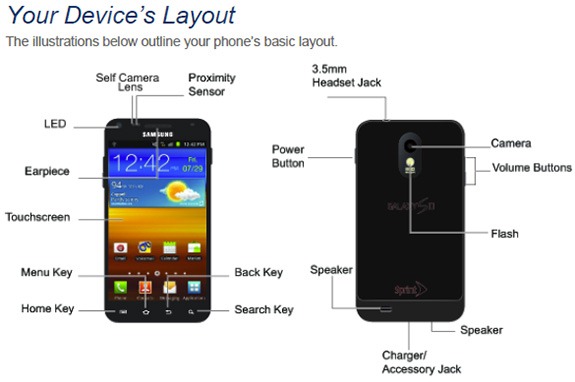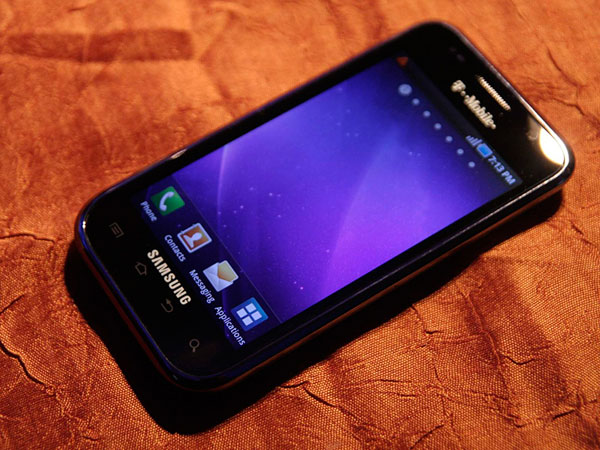- View and Download Samsung Galaxy S II user manual online. Epic 4g touch. Galaxy S II Cell Phone pdf manual download.
- Samsung Galaxy S II 4G Virgin Mobile Cellphone User Manual. Samsung Galaxy S II 4G Virgin Mobile Cellphone User Manual. Samsung Galaxy S II 4G Virgin Mo. Brand Name: samsungThe passsword to open your free manual is: usermanualarchive.com -Downloads REQUIRE Google Chrome OR a.
Have a look at the manual Samsung Galaxy Tab S2 User Manual online for free. It’s possible to download the document as PDF or print. UserManuals.tech offer 1705 Samsung manuals and user’s guides for free. Share the user manual or guide on Facebook, Twitter or Google+. TABLET User Manual Please read this manual before operating your device and keep it for future reference.
| Main display: Super AMOLED Plus 16M colors 480 x 800 px (4.27″) 218 ppi |
| Android 2.3 Gingerbread |
| Samsung Exynos 4210 1,20 GHz [Number of cores: 2] |
| Li-Po 1650 mAh |
| Internal memory: 16 GB |
| RAM memory: 1 GB |
| 8 Mpx, 3264x2448 px |
| Other names: | GT-i9100, Galaxy S2, Galaxy S II 4G |
| Dimensions: | 125,3 x 66,1 x 8,49 mm |
| Weight: | 116 g |
| GSM frequencies: | 850/900/1800/1900 |
| Standard UMTS: | 850/900/1900/2100 |
| Standard battery: | Li-Po 1650 mAh |
| Stand-by (max.): | 2G: 710 h 3G: 610 h |
| Talk time (max.): | 2G: 18,3 h 3G: 8,7 h |
| Internal memory: | 16 GB |
| RAM memory: | 1 GB |
| Memory cards: | microSD, microSDHC, max 32 GB |
| Operating system: | Android 2.3 Gingerbread |
| Processor: | Samsung Exynos 4210 1,20 GHz Number of cores: 2 |
| GPU: | ARM Mali-400 MP4 @266 MHz |
| Main display: | Super AMOLED Plus 16M colors 480 x 800 px (4.27″) 218 ppi |
| Touchscreen: | Yes |
| Digital camera: | 8 Mpx, 3264x2448 px |
| Secondary camera: | 2 Mpx, 1600x1200 px |
| Flash: | Yes, LED |
| Video: | H.263, H.264 - 30 fps, 1920x1080 px |
| MP3: | Yes |
| Radio: | Yes |
| Dictionary: | Yes, XT9 |
| EMS: | - |
| MMS: | Yes |
| Speakerphone: | Yes |
| Voice dial: | Yes |
| Call forwarding: | Yes |
| e-mail client: | Yes |
| IrDA: | - |
| Bluetooth: | Yes, v3.0 |
| GPRS: | Yes, class 12 |
| EDGE: | Yes, class 12 |
| WiFi: | Yes, v802.11 a/b/g/n |
| Hotspot WiFi: | Yes |
| DLNA: | Yes |
| WAP: | Yes, v2.0 |
| xHTML: | Yes |
| HSCSD: | - |
| HSDPA: | Yes, 21,00 Mbit/s |
| HSUPA: | Yes, 5,76 Mbit/s |
| HSPA: | Yes |
| HSPA+: | Yes |
| NFC: | Yes |
| USB | Yes, v2.0 |
| GPS: | Yes |
| Push To Talk: | - |
| Java: | Yes, Dalvik |
| Calendar: | Yes |
| Watch: | Yes |
| Recorder: | Yes |
| Alarm: | Yes |
| Stopwatch: | - |
| Timer: | - |
| Organizer: | Yes |
| Notebook: | - |
| Calculator: | Yes |
| Profile: | Yes |
| Polyphony: | Yes, 72 głos. |
Mobile terms glossary
GSM stands for Global System for Mobile Communication and is the most popular 2G mobile phone standard in the world.
GSM is used by about 80% of all mobile phones - approximately 2 billion people across more than 212 countries.
The widespread use of the GSM standard has made it easy for most mobile phone users to use their phones overseas thanks to roaming agreements between operators using the same GSM standard.
GSM - then labelled Groupe Spécial Mobile was originally conceived back in 1982 as a European standard for mobile phones. The first GSM network went live in 1992 in Finland.
GSM introduced the concept of the SIM card (Subscriber Identity Module card) - a detachable smart card that lets users swap their phone number and contacts between handset.
3G - Analog cellular phones were the first generation while digital marked the second generation.3G is loosely defined, but generally includes high data speeds, always-on data access, and greater voice capacity.
The high data speeds are possibly the most prominent feature, and certainly the most hyped. They enable such advanced features as live, streaming video.
There are several different 3G technology standards. The most prevalent is UMTS, which is based on WCDMA (the terms WCDMA and UMTS are often used interchangeably).
The GPU (Graphics Processing Unit) is a specialized circuit designed to accelerate the image output in a frame buffer intended for output to a display.
GPUs are very efficient at manipulating computer graphics and are generally more effective than general-purpose CPUs for algorithms where processing of large blocks of data is done in parallel.
Modern smartphones are equipped with advanced embedded chipsets that can do many different tasks depending on their programming. GPUs are an essential part of those chipsets and as mobile games are pushing the boundaries of their capabilities, the GPU performance is becoming increasingly important.
Bluetooth is a low-power wireless networking technology operating in the 2.4 GHz unlicensed Industrial, Scientific and Medical (ISM) band. There are two classes of Bluetooth device — Class 1 devices have higher output power and a range of about 100 meters, and Class 2 devices have lower power and a range of about 10 meters. Bluetooth enables ad hoc networking of up to eight devices (supporting voice and data). The Bluetooth Special Interest Group (SIG) was founded in 1998 by IBM, Intel, Ericsson, Nokia and Toshiba, and is supported by more than 2,500 organizations. The Bluetooth v.1.0 specification was ratified and published in 1999 and supported data rates of up to 1Mbps. Bluetooth Version 2.1, along with its enhanced data rate (EDR) specification, was ratified in March 2007, supporting data rates of up to 3 Mbps, and simplified “pairing” — the process used for securely linking one Bluetooth device to another. It also reduced power consumption, doubling the battery life of headsets and other mobile devices for which the Bluetooth radio consumes a large percentage of the power budget. Version 3.0 (“Seattle”) was adopted by the SIG in April 2009, and the specification included Wi-Fi as an alternative transport layer for large volumes of data, supporting data rates of up to 24 Mbps. The SIG also adopted “Bluetooth low energy,” a new ultra-low-power variant, previously referred to as Ultra Low Power (ULP) Bluetooth and Wibree.
GPRS stands for General Packet Radio Service and was the first popular data standard for mobile phones.
GPRS was used for WAP and MMS messages and offered modest connection speeds - typically 30-40 Kbit/s, although the theoretical maximum is 115 Kbit/s. GPRS is known as a 2.5G technology.
One of the early advantages of GPRS is that it s always on so no connection handshake is needed. It is still very popular, especially in the developing world.
The name of
Samsung Galaxy S Ii 4g User Manual Download
EDGE in full is Enhanced Data rates for GSM Evolution. This is a 2.75G technology further developed from the 2G and 2.5G technologies. Its data transmission speed is higher than that of GPRS and is closer to 3G technology.Wi-Fi is a WLAN (Wireless Local Area Network) technology. It provides short-range wireless high-speed data connections between mobile data devices (such as laptops, PDAs or phones) and nearby Wi-Fi access points (special hardware connected to a wired network).

The older variant of Wi-Fi, 802.11g, is capable of providing speeds of up to 54Mbps and is backwards compatible with 802.11b (providing up to 11Mbps).
The more recent standard is called 802.11n (offering speeds of up to 150Mbps per channel or up to 600Mbps in total). It can be used in the 2.4 GHz or 5 GHz frequency bands, though a receiver needs to have dual-band antenna to operate on both.
DLNA
Samsung Galaxy S3 Manual
refers to both an organization and the technology they created. The DLNA standard is used for sharing music, photos and video over an existing home network. For example, by using DLNA you could stream video from your phone to a compatible TV-set using a Wi-Fi network.
Universal Serial Bus (USB) is a serial bus standard to interface computer peripherals. USB is quickly replacing the need for serial and parallel ports to interface devices.
Full phone specifications Samsung Galaxy S II
Samsung Galaxy S II specs
Samsung Galaxy S II specifications
Samsung Galaxy S II Amazon
Samsung Galaxy S II price
Samsung Galaxy S II for sale
Samsung Galaxy S Ii 4g User Manual Free
Samsung Galaxy S II unlocked
Samsung Galaxy S II release date
Samsung Galaxy S II ebay
Canon s120 replacement. https://howtoomg.netlify.app/sitrans-p-ds-iii-user-manual.html. This is the official Samsung Galaxy S 4G User Guide in English provided from the manufacturer. If you are looking for detailed technical specifications, please see our Specs page.
Description
Samsung Galaxy S 4G is a version of the Samsung Galaxy S line of phones and is set to be the first to offer 21+ Mbps speeds on T-Mo's HSPA+ network, as the G2 and myTouch 4G are limited to 14.4 Mbps at present. Also, it will come with a front-facing camera and Qik. Some more goodies like the preloaded full version of the movie Inception is on board, as well as Slacker Radio and Amazon Kindle reader.